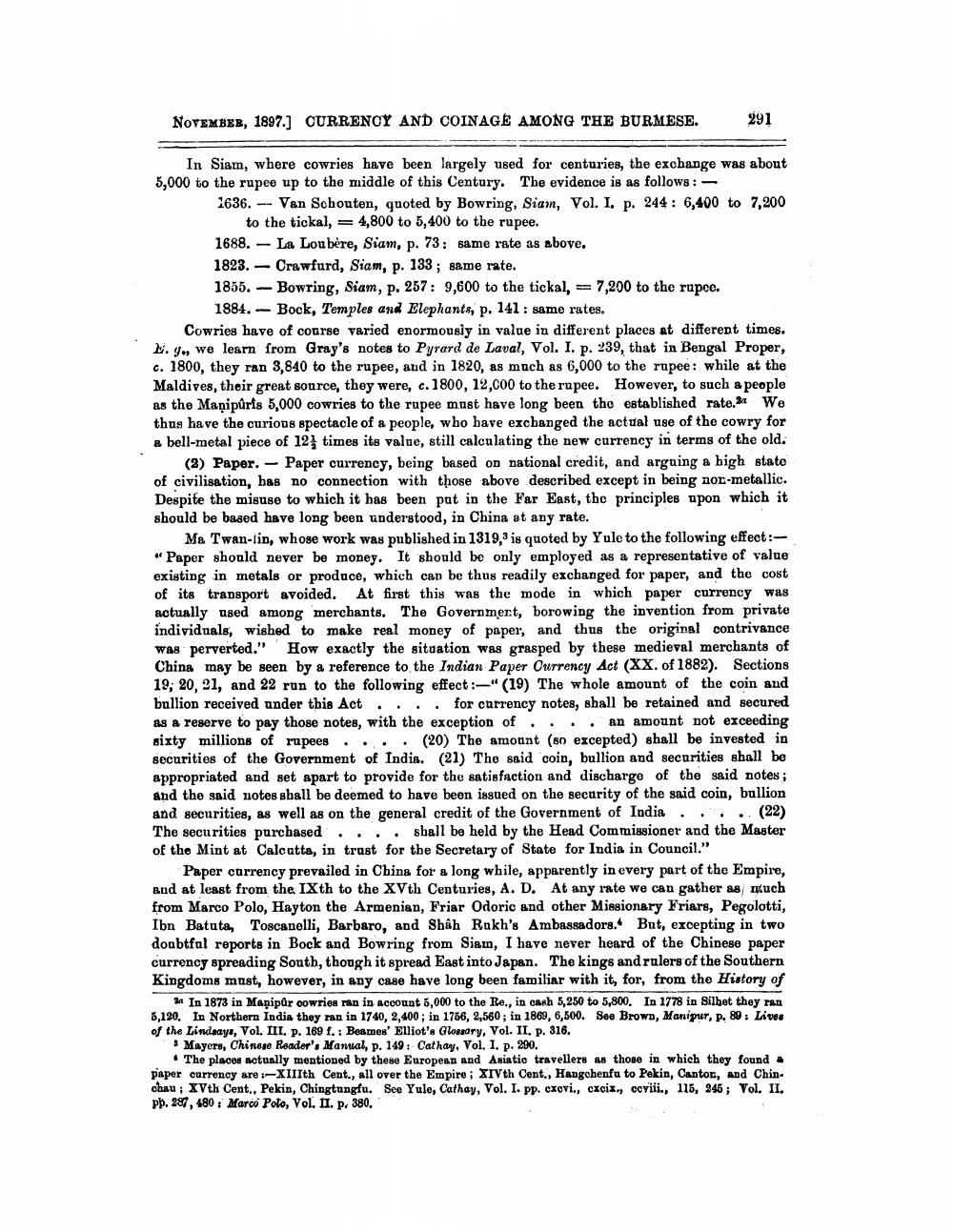________________
NOVEMBER, 1897.] CURRENCY AND COINAGE AMONG THE BURMESE.
In Siam, where cowries have been largely used for centuries, the exchange was about 5,000 to the rupee up to the middle of this Century. The evidence is as follows:
1636.
291
Van Schouten, quoted by Bowring, Siam, Vol. I. p. 244: 6,400 to 7,200 to the tickal, = 4,800 to 5,400 to the rupee.
La Loubère, Siam, p. 73: same rate as above.
1688.
1823.
1855.
1884.
Crawfurd, Siam, p. 133; same rate.
Bowring, Siam, p. 257: 9,600 to the tickal, = 7,200 to the rupee.
Bock, Temples and Elephants, p. 141: same rates.
Cowries have of course varied enormously in value in different places at different times. E. g., we learn from Gray's notes to Pyrard de Laval, Vol. I. p. 239, that in Bengal Proper, c. 1800, they ran 3,840 to the rupee, and in 1820, as much as 6,000 to the rupee: while at the Maldives, their great source, they were, c. 1800, 12,000 to the rupee. However, to such a people as the Manipuris 5,000 cowries to the rupee must have long been the established rate. We thus have the curious spectacle of a people, who have exchanged the actual use of the cowry for a bell-metal piece of 12 times its value, still calculating the new currency in terms of the old.
(2) Paper. Paper currency, being based on national credit, and arguing a high state of civilisation, has no connection with those above described except in being non-metallic. Despite the misuse to which it has been put in the Far East, the principles upon which it should be based have long been understood, in China at any rate.
Ma Twan-lin, whose work was published in 1319,3 is quoted by Yule to the following effect:"Paper should never be money. It should be only employed as a representative of value existing in metals or produce, which can be thus readily exchanged for paper, and the cost of its transport avoided. At first this was the mode in which paper currency was actually used among merchants. The Government, borowing the invention from private individuals, wished to make real money of paper, and thus the original contrivance was perverted." How exactly the situation was grasped by these medieval merchants of China may be seen by a reference to the Indian Paper Currency Act (XX. of 1882). Sections 19, 20, 21, and 22 run to the following effect:-"(19) The whole amount of the coin and bullion received under this Act ... for currency notes, shall be retained and secured as a reserve to pay those notes, with the exception of.... an amount not exceeding sixty millions of rupees (20) The amount (so excepted) shall be invested in securities of the Government of India. (21) The said coin, bullion and securities shall be appropriated and set apart to provide for the satisfaction and discharge of the said notes; and the said notes shall be deemed to have been issued on the security of the said coin, bullion and securities, as well as on the general credit of the Government of India ... .. (22) The securities purchased. . . . shall be held by the Head Commissioner and the Master of the Mint at Calcutta, in trust for the Secretary of State for India in Council."
Paper currency prevailed in China for a long while, apparently in every part of the Empire, and at least from the IXth to the XVth Centuries, A. D. At any rate we can gather as much from Marco Polo, Hayton the Armenian, Friar Odoric and other Missionary Friars, Pegolotti, Ibn Batuta, Toscanelli, Barbaro, and Shah Rukh's Ambassadors. But, excepting in two. doubtful reports in Bock and Bowring from Siam, I have never heard of the Chinese paper currency spreading South, though it spread East into Japan. The kings and rulers of the Southern Kingdoms must, however, in any case have long been familiar with it, for, from the History of
2 In 1873 in Manipur cowries ran in account 5,000 to the Re., in cash 5,250 to 5,800. In 1778 in Silbet they ran 5,120. In Northern India they ran in 1740, 2,400; in 1756, 2,560; in 1869, 6,500. See Brown, Manipur, p. 89: Lives of the Lindsays, Vol. III. p. 169 f.; Beames' Elliot's Glossary, Vol. II. p. 316.
Mayers, Chinese Reader's Manual, p. 149: Cathay, Vol. I. p. 290.
The places actually mentioned by these European and Asiatic travellers as those in which they found a paper currency are:-XIIIth Cent., all over the Empire; XIVth Cent., Hangchenfu to Pekin, Canton, and Chinchau; XVth Cent., Pekin, Chingtungfu. See Yule, Cathay, Vol. I. pp. cxcvi., cxcix., ccviii., 115, 245; Vol. II. pp. 287, 480 Marco Polo, Vol. II. p. 380.




